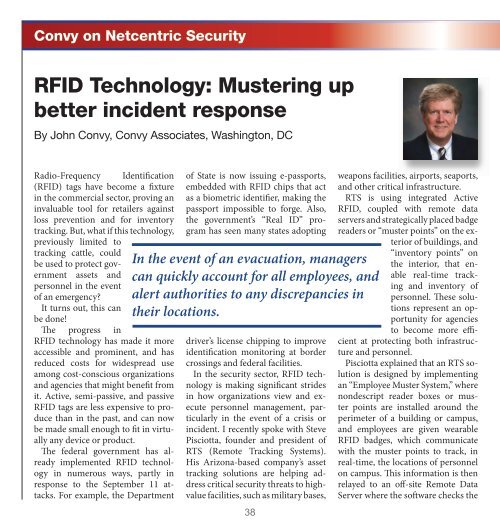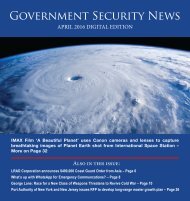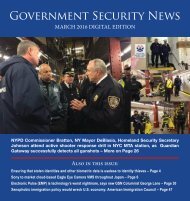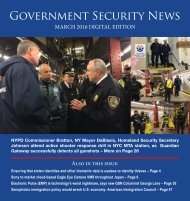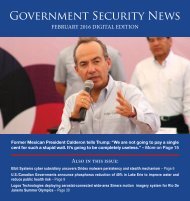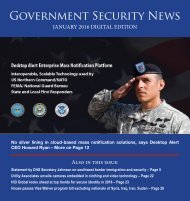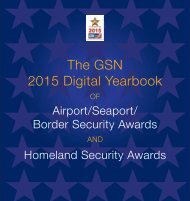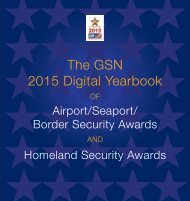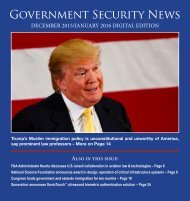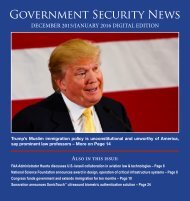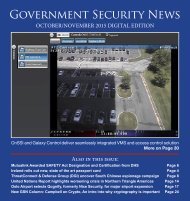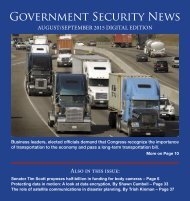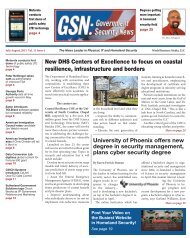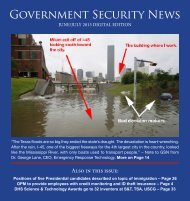GSN March 2016 Digital Edition
Create successful ePaper yourself
Turn your PDF publications into a flip-book with our unique Google optimized e-Paper software.
Convy on Netcentric Security<br />
RFID Technology: Mustering up<br />
better incident response<br />
By John Convy, Convy Associates, Washington, DC<br />
Radio-Frequency Identification<br />
<br />
in the commercial sector, proving an<br />
invaluable tool for retailers against<br />
loss prevention and for inventory<br />
<br />
previously limited to<br />
tracking cattle, could<br />
be used to protect government<br />
assets and<br />
personnel in the event<br />
of an emergency?<br />
It turns out, this can<br />
be done!<br />
The progress in<br />
RFID technology has made it more<br />
accessible and prominent, and has<br />
reduced costs for widespread use<br />
among cost-conscious organizations<br />
and agencies that might benefit from<br />
it. Active, semi-passive, and passive<br />
RFID tags are less expensive to produce<br />
than in the past, and can now<br />
be made small enough to fit in virtually<br />
any device or product.<br />
The federal government has already<br />
implemented RFID technology<br />
in numerous ways, partly in<br />
response to the September 11 attacks.<br />
For example, the Department<br />
of State is now issuing e-passports,<br />
embedded with RFID chips that act<br />
as a biometric identifier, making the<br />
passport impossible to forge. Also,<br />
the government’s “Real ID” program<br />
has seen many states adopting<br />
In the event of an evacuation, managers<br />
can quickly account for all employees, and<br />
alert authorities to any discrepancies in<br />
their locations.<br />
driver’s license chipping to improve<br />
identification monitoring at border<br />
crossings and federal facilities.<br />
In the security sector, RFID technology<br />
is making significant strides<br />
in how organizations view and execute<br />
personnel management, particularly<br />
in the event of a crisis or<br />
incident. I recently spoke with Steve<br />
<br />
<br />
His Arizona-based company’s asset<br />
tracking solutions are helping address<br />
critical security threats to highvalue<br />
facilities, such as military bases,<br />
38<br />
weapons facilities, airports, seaports,<br />
and other critical infrastructure.<br />
RTS is using integrated Active<br />
RFID, coupled with remote data<br />
servers and strategically placed badge<br />
readers or “muster points” on the exterior<br />
of buildings, and<br />
“inventory points” on<br />
the interior, that enable<br />
real-time tracking<br />
and inventory of<br />
personnel. These solutions<br />
represent an opportunity<br />
for agencies<br />
cient<br />
at protecting both infrastructure<br />
and personnel.<br />
lution<br />
is designed by implementing<br />
an “Employee Muster System,” where<br />
nondescript reader boxes or muster<br />
points are installed around the<br />
perimeter of a building or campus,<br />
and employees are given wearable<br />
RFID badges, which communicate<br />
with the muster points to track, in<br />
real-time, the locations of personnel<br />
on campus. This information is then<br />
relayed to an off-site Remote Data<br />
Server where the software checks the


